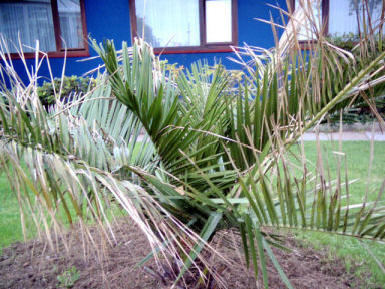
Inspection Round October 2005
My wife and I went from Hamburg to Heligoland by the Halunder Jet (catamaran). This time we also brought some donated plants to the red island. The largest plant was a Araucaria angustifolia approx. 6 ft. tall donated by Dr. Bernhard Demes. Further but smaller specimens are to follow within the next years. We also brought Yucca rostrata, two xChitalpa taschkentensis, a Puya coquimbensis, a Nerium oleander, an Idesia polycarpa, a Cinnamomum camphora, three Rhopalostylis sapida and a Fuchsia magellanica hybrid.
It was no problem to get all plants on board and everything ran as smoothly as it did in May 2005 when we brought the specimen of Juania australis to Heligoland.
Ulf fetched us from the harbour and he was surprised to see the large Paraná pine (Araucaria angustifolia) and all the other plants.
At first, we went to the Insulaner Jubaea at the south promenade. The Jubaea looked much better than in spring 2005 and has produced four new feather leaves. It is beginning to establish now which is a promissing sign. Mr. Rickmers was also present and welcomed us and I could inform him that his palm was much better now.

Jubaea chilensis at the hotel "Insulaner" with new four feather leaves in
October 2005
The two trachcarpus in the wooden excavator buckets standing near the hotel "Insulaner" have recovered again as well and looked much better now, with its fans much shorter stalked and better adapted to the Heligolanidan conditions.
The many Fatsia japonica on Heligoland also have recovered completely and already began to flower. We took the elevator up to the Upper Town and brought the plants to the school. However, Ulf told me that according to his experience the "exotics" having been planted out in spring had grown much better and would therefore be more prepared to cope with cold winter weather. Therefore, he is planning to overwinter most of the plants frost free before planting them out next spring. The first and foremost problem here is the salty sea wind in winter. It was a place problem at my home that made me bring plants to Ulf for overwintering in the first place.
We then looked after the "exotics" in the atria, and most of them have made good progess, with some of them even having developed surprisingly well. Aloe striatula has recovered completely and is now much larger.
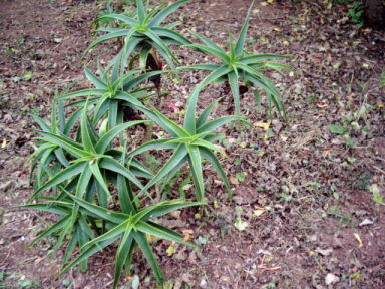
Aloe striatula in October 2005
Araucaria heterophylla come back again as well but probably suffered more from shoot damages than from frost. Whether it can survive continuously here will been seen. Surely, Araucaria angustifolia could be the better alternative but it will be planted out not before next spring because of possible windbreak during winter storms. The eucalyptus also did well, some having grown into sizeable plants. Perhaps they could grow to really large trees here if they manage to develop a good resistance against salt and wind.
Cycas revoluta has grown 5 new leaves. Amanzingly, since it it believed that this species would need higher temperatures to grow well. One Albizzia als has grown well and Pinus radiata and the recently planted Cupressus macrocarpa 'Goldcrest' presented themselves in good shape as well.
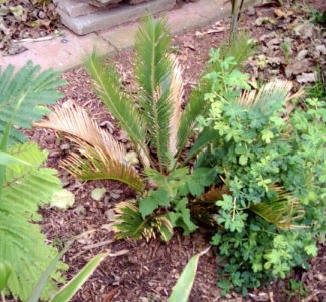
Cycas revoluta with 5 new leaves and Polylepsis australis in
October 2005
Phygelius sp. even has developed into a firm bush and the New Zealandians also grew very well whereas Caesalpinia gillesii only grew slowly.
Leptospermum scoparium 'Apple Blossom' showed a particularly good performance but seems to have sustained some damage from salty seawinds. Therefore, it is somewhat doubtful if it will survive here on the long run.
Polylepsis australis from the Peruvian highlands has survived so far but still has to go through the next winter with its salty winds. Nothofagus dombeyi succumbed to the salt and wind. Callistemon citrinus has produced new shoots, but last years winter damages can still be seen. The other species all grew well but they still have to prove their salt and wind resistance.
Metrosideros excelsa from New Zealand has proven suitable for Heligoland at least in this summer. It is salt wind tolerant but still has to prove its hardiness on Heligoland. Metrosideros excelsa is not hardy enough even in the German mainland´s mildest areas.
But there are always surprises such as Aloe striatula which usually is not hardy even in the mildest areas here but surprisingly has survived the past winter without any protection in a relatively good shape and has grown quite well.
Metrosideros excelsa reportedly grows along Great Britain´s southwestern coastlines.
Entelea arborescens was in an amazingly good condition despite of its large leaves and has grown well . Chamaerops humilis has established well producing some firm short stalked "Heligoland Fans".
The trachies in the atrium #2 as well as the ex-Atoll trachy are in a better condition now, all having grown short stalked fans which are better adapted to the climate of Heligoland. The Trachycarpus wagnerianus looked respectable again as well.
The Brahea armata has grown new firm blueish leaves and the Phoenix canariensis I brought here last year has regenerated very well. Phoenix species, especially Phoenix canariensis will stand a good chance of surviving here in well sheltered places.
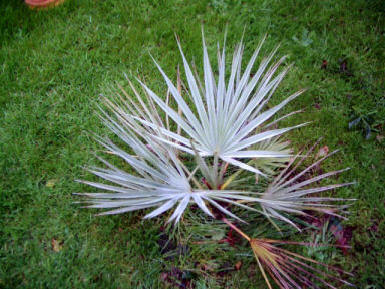
Brahea armata in October 2005
Unfortunately, it began to rain and a stormy wind blew. Ulf advised us to stay one more night because the ship link was uncertain because of the bad weather.
We then visited the ex-Atoll trachy which was in a sad condition. It had a fungus infection and Ulf had dug it up again, put in a pot and treated it with copper sulfate. The leaves were all gone and no spear could be seen any more. It was not affected by cold but the problem was that it grew too close to the coast and at its old place at the elevator tower near the hotel "Atoll" it was too much exposed to the salty seawinds.
The Mexican grass tree (Dasylirion quadrangulatum) was still in a pot and will be planted out in spring 2006.
The only exotic plant of the first wave of plantings done in 2004 that has etablished very well is Pittosporum tobira. I has grown very well just as if it was made for this island, because it has shown good wind and salt resistance. So it deserves a further spreading over the island, but at first it has to go through its second winter. Unfortunately, Quercus suber has proven to be not very salt wind resistant as only a few new shoots have come from the root base of the cork oak.
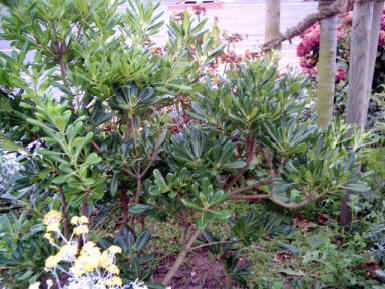
Pittosporum tobira in October 2005 - like created for the island!
Arundo donax and Dahlia excelsa have developed well on the slope between the gym and the stairs. Above all the growth of Dahlia excelsa surprised me since it has become nearly head-high despite of the cool Heligolandian summer.
Most bamboos also did well.
We then checked Ulf´s garden where a Washingtonia filifera was planted close to the house wall next to a Trachycarpus martianus and a small Trachycarpus wagnerianus. All looked fine and Ulf will plant them a bit further away from the wall when they have grown bigger.
The Rhododendron macabeanum standing in a very wind sheltered spot under a shrub was the only survivor of its species on the island because rhododendrons are not very salt wind tolerant. However, this one looked fairly well. The red leafed cordyline, some yuccas and an ex-Atoll-chamaerops also left a very good impression. Next spring Ulf is planning to plant my Yucca rostrata into his garden.
After we having unsuccessfully tried to find a Washingtonia at the power station on the Northeastern Area, we went to the cure park and swimming pool. The Yucca gloriosa donated by Prof. Dr. Warda hardly has any problems on Heligoland.
The Trachycarpus wagnerianus at the swimming pool has grown some new but shorter stalked fans, but it did not look too beautiful because its older fans which had been damaged by the salty seawinds had not been cutt off. However, the new fans seems to have adapted better to the Heligolandian conditions. The Trachycarpus fortunei in the bush in the cure park next to the two specimens of Araucaria araucana and the two Agave americana dug in with pots presented themselves in a very good shape.
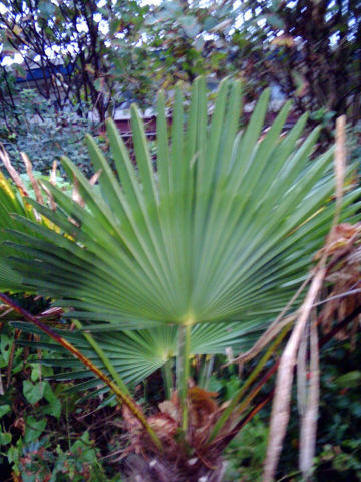
Trachycarpus wagnerianus at the swimming pool in October 2005 -
new shorter stalked fans!
In Down Town Heligoland City we discovered the two Cordyline australis planted out at the bistro “Sansibar” in 2003. Both have managed to survive but one of them has developed better than the other. Unfortunately, I couldn't find Viburnum tinus any more.
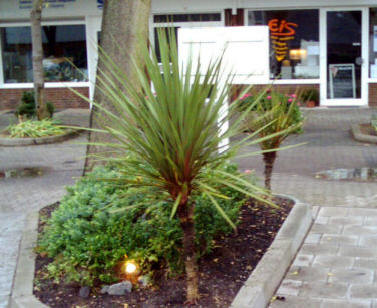
Cordyline australis at the bistro "Sansibar" in October 2005
In the next morning I continued my inspection in the atria of the school and could not stop wondering about what I saw there.
The opuntias, the recently planted agaves, as well as the aloes have done very well and they seem to be suitable for Heligoland. One of the Jubaeas has produced 3 new fronds and a new spear. Very surprisingly, the Butia capitata has also recovered and has produced one new leaf. However, the question remains if it will managed to etablish here in the long run.
The different eucalyptus species like Eucalyptus crenata, E. globulus ssp. bicostata, E. rodwayi and others have also grown quite well. It would be wonderful if some species do prove suitable for Heligoland. The specimens of Chamaerops humilis in the same atrium also have developed well. Phormium tenax seems to have established itself here definitely and has grown strongly since my last inspection. So it seems to be recommendable for Heligolandian gardens.
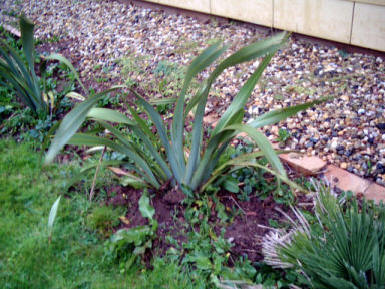
Phormium tenax in the atrium #2 of James Kruess School in October 2005
Unfortunately, part of the oleanders and nearly all of the citrus trees were gone. Oleanders and citrus trees should be tried here only in very well sheltered and warm spots on Heligoland. Musa basjoo also has not grown here to the same hight as some specimens did in my garden in Hamburg. They only grew approx. 2 feet tall in comparsion to my approx. 10 feet tall basjoos.
The tree ferns looked much better now, especially the Cyathea dregei and one Dicksonia antarctica. Furthermore, Choisya ternata and Ch. ternata 'Sundance' also seem to be suitable for Heliogland .Next winter will tell if they really are more salt and wind tolerant than citrus trees. Choisya ternata is closely related to the genera Citrus and Poncirus.
I was even more amazed about the Musella lasiocarpa from Koba Koba which has recovered without having received any winter protection. I would have never exspected it to do so since this species has proved not hardy on the German mainland without protection. However, due to the lack of warmth here it has not grown very tall but seems to be able to survive here on Heligoland without protection if planted in a sheltered spot, as we did at the power station on the Northeastern Area where is growing right next to the Washingtonia.
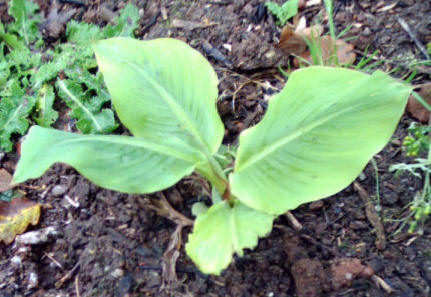
Musella lasiocarpa has survived the winter 2004/05 without winter protection on
Heligoland!
Diospyros kaki has also grown amazingly well. It seems that Kakis can be grown like figs on the island, as this species is completely hardy on Heligoland.
I was even more surprised when I checked the Washingtonia filifera formerly standing at the hotel "Atoll" and which was replanted in the atrium.I has recovered and looked healthy again having produced four new fans and a fibrous spear typical for this species. Washingtonias could also thrive here in well sheltered spots.
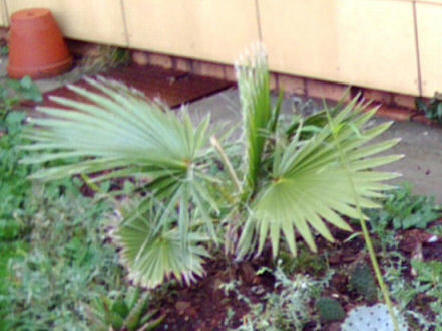
Washingtonia filifera also has survived the winter 2004/05 in the atrium #2 of
James Kruess School!
I then checked the plants in atrium #1 which also took me by surpise. especially because the bambo at the pond has recovered well. Unfortunately, 'Swingle Citromelo' was gone as most of the citrus trees on Heligoland despite of the good cold hardiness of this Hybrid. Behind the greenhouse I found the Juania australis. Ulf had planted in at a well wind sheltered site and has not removed the weed there. The Juania australis has grown fairly well and was in a good condition. Since Juania is dioceous, one needs one specimen of each gender to be able to harvest seeds one day.
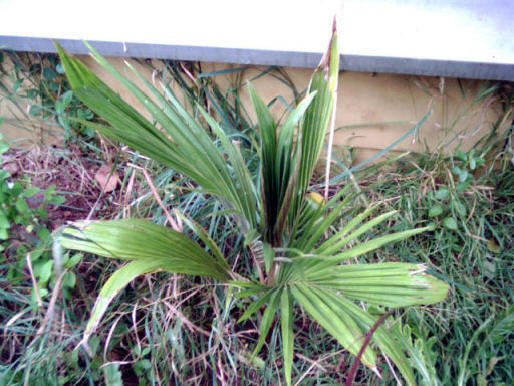
Juania australis in October 2005
The larger specimen of Metrosideros excelsa looked excellent, but the two smaller plants in the atrium #2 have grown even better and stronger. Thus, this species has proved to be salt and wind resistant. Whether it will also prove winter hardy on Heligoland will be seen next Spring.
Myrtus communis and Pittosporum ralphii in Atrium #2 also had no problems in the past summer and have grown very well. One small Olea europaea has recovered as well as the recently planted larger olive and the Olea sylvestris from Chris have grown well and have no problem with the Heligolandian summer. Nevertheless, we hope that the coming winter will not be so stormy as the last one and will be more similar to the winter 2003/04.
It also surprised me that Clianthus puniceus in the atrium #2 has grown that well and also the Passiflora caerulea we recently planted under a tree which even has flowered, proving that the site under the tree is much better for this species than the windy spot in the atrium #4 where even the ivy is struggling.
The large Phoenix canariensis in the atrium #1 which I brought to the island in spring 2005, had damages on its fronds from the salty wind and from sunburn. Obviously, they were previously grown in greenhouses were they grew soft fronds. However, the newly produced fronds of the other Phoenix canariensis in the atrium #2 have already adapted much better to the Heligoland conditions. Fortunella japonica still carried ripened fruits.
The magnolias (Magnolia grandiflora and M. stellata) are vital. Musa basjoo at the greenhouse has regrown from the rhizome, but has not suckered. It was almost as large as it was last year, i. e. approx. 2 feet.
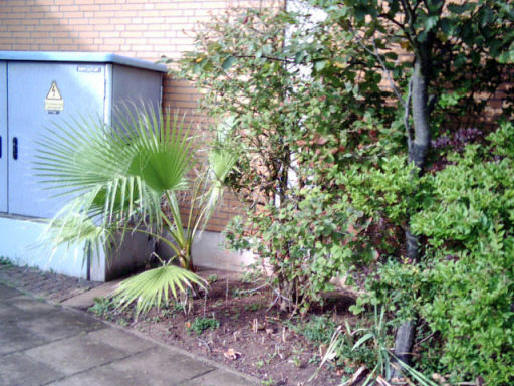
Sensational! Washingtonia filifera thriving at the power station on the Northeastern Area for
three years!
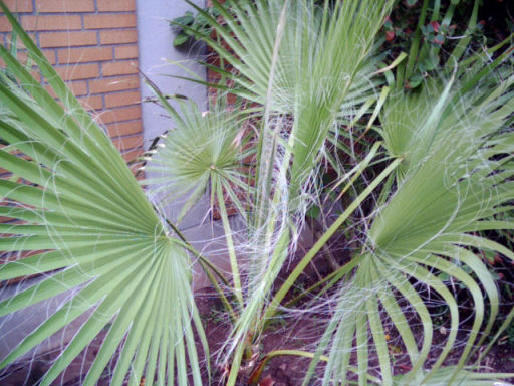
Close view of the Washingtonia filifera at the power station with the obvious features.
In the meantime the weather had improved and in Down Town Heligoland City I was able to trace the blue house with the palms in the front yard. However, the Cordyline australis was gone. Only a dead stump marked the spot where it was planted.
Maybe it was broken by stormy wind but perhaps it will come back from the roots like the one in the atrium of the school. The Chamaerops humilis was in a very good condition, also the trachy was okay. And in the direct neighbourhood another Trachycarpus has been planted there since our last visit.
In the evening I discovered a fruiting Cordyline australis in the vicinity of an Italian restaurant with ripened white fruits. I picked some seeds and will check if they are fertile. If the seeds germinate, then the seedlings will be brought back to Heligoland. There is also the chance that some seeds will drop off and germinate without any help making the cordyline a self propagating plant on Heligoland.
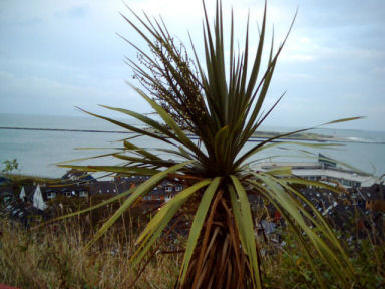
Cordyline australis with fruit in October 2005
On the following morning it was still rainy, but the weather then improved and got drier. One last time I inspected atrium #3 of the school looking for Schinus molle. It was still alive. Syagrus romanzoffiana has grown slowly but still looked relatively fine. But will it survive the coming winter and start growing well next year?
We then went to the "Witte Kliff" house to examine the "exotics" planted there. Phyllostachys aurea made a good impression. Very surprisingly a Cyperus alternifolius has survived the winter and has not only recovered completely but has grown considerably. Actually this species is not hardy on the German mainland! One could keep it as a perennial plant on Heligoland outdoors and we will take more plants of this species to the island.
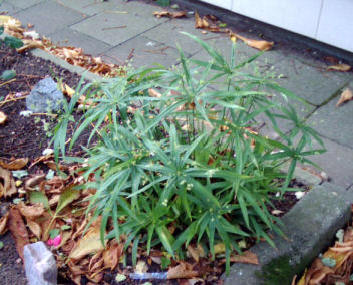
Also one sensation! Cyperus alternifolius has survived the winter
2004/05 without winterprotection and has regrown.
Tim Pyschny´s oleander looked very good and obviously feels well. Oleanders can survive on Heligoland only in very well sheltered places since they are not very salt tolerant although being completely cold hardy on Heligoland.
Furcraea longaeva 'Variegata' has never shown any problems here and has developed well. Ulf also has got one now in his garden. The two Callistemon laevis also survived but although having grown some new leaves they have not shed their old damaged leaves yet.
I also inspected Pleioblastus simonii, Phyllostachys bissettii and Physt. boryana at the hotel "Atoll" but only Pleioblastus has survived and etablished whereas the two specimens of Phyllostachys were dead. Probably they are not suitable for spots directly exposed to sea wind.
We then proceded to the Mielck House were both large Quercus ilex had recovered again, but some shoots were so heavily damaged by the salty winter wind that they died. However, the large laurel tree looked okay again but the holm oaks will need more time to completely recover from previously sustained damages. Let´s hope that the coming winter will not be that windy again.
This time we were lucky as Mrs. Dr. Karen Wiltshire's boyfriend was in and opened us the doors to the inner courtyard. I was pleasantly surprised. Only Nerium oleander 'Atlas' and Olea europaea did not survive the past winter, clearly because of the bad salty wind whereas Opuntia sp. from Joerg Witticke, Opuntia santa-rita and Cylindropuntia imbricata from Manfred Nold, Delosperma cooperi, Yucca aloifolia and Chamaerops humilis survived and some of them even have grown well. Delosperma cooperi has spread out strongly and is now covering nearly half of the bed! The ideal noon flower for Heligoland, perfectly suitable for the sandy soil in the Northeastern Area! We should try further noon flower species which are not hardy on the German mainland, but might surprise us here. Replacement plantings we will be carried out in spring 2006, including further noon flowers and Aloe aristata.
We then visited the hotel "Insulaner" where I informed Mr. Rickmers about the results of my inspection. We also visited his garden wherea Musa basjoo 'Sapporo' has regrown from the ground. It is one of the first bananas on Heligoland which stayed alive something Prof. Dr. Kuckuck had been unable to achieve nearly 100 years ago, and we did it without any winter protection! It was even somewhat larger than past year, but still much smaller than expected. I had hoped it could have grown approx. 5 to 7 feet tall. However, I am sure that a Musa basjoo planted at at the power station will eventually reach that size.
The strawberry tree (Arbutus unedo) was in full bloom again but it has dropped all its last year´s foliage.
Callistemon citrinus has got new foliage dropping the old foliage completely quite contrary to the conspecifics in the atrium of the school.
I was pleased to see that the Butia capitata from Manfred Nold has grown one and half new leaves. Cupressus sempervirens and C. macrocarpa 'Goldcrest' are green again but still salt wind damages on older branches can be seen. Thererfore, with limitations, Cupressus sempervirens and C. macrocarpa can be regarded as suitable for Heligoland, but they experience the same problems here as the species of Chamaecyparis.
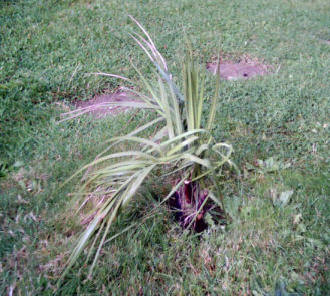
Butia capitata in the garden of the hotel "Insulaner" in
October 2005
Acacia dealbata planted at one hotel wall has regrown from the trunk and Mrs. Rickmers had cut the dead parts off. So, just like oleanders, Acacia dealbata is suitable here but only in sheltered down town sites.
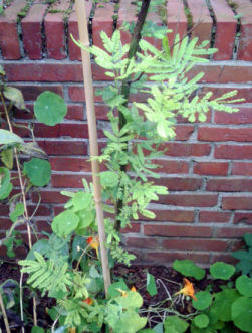
Acacia dealbata in the garden of the hotel
"Insulaner" has survived the winter 2004/05
unprotected!
Unfortunately, the Jubaea seedling was dead. It probably dried out during spring which was exceptionally dry. We believe that it is advisable to plant here only specimens of Jubaea chilensis larger than about 3 feet although other small Jubaea seedlings did survive. Unfortunately, the larger specimens of this species are relatively expensive. However, the large Jubaea chilensis in front of the entrance of the hotel "Insulaner" proves that older and etablished specimens of this species can thrive well here under the same conditions as Trachycarpus fortunei and Trachycarpus wagnerianus.
Phormium tenax seemed to have disappeared maybe under the grass or it dried out. From the now large specimens in the atrium #2 of James-Krüss-School we learned that it is better not to plant too small specimens of Phormium tenax.
Arundo donax 'Variegata' has also regrown but only with one stem.
The two Chamaerops humilis looked fine and seem to get along with the conditions there. They were partly overgrown by Cotoneaster which will have to be cut back next spring.
Yucca recurvifolia still is in a good shape as well as Aloe striatula which semms to grow well here and which is probably hardy on Heligoland without winter protection.
Opuntias also seem to do well on Heligoland. Unfortunately, the opuntia in the garden of the hotel "Insulaner" was overgrown by some shrubs which also will have to be cut back.
cut back next spring.
Yucca recurvifolia still is in a good shape as well as Aloe striatula which semms to grow well here and which is probably hardy on Heligoland without winter protection.
Opuntias also seem to do well on Heligoland. Unfortunately, the opuntia in the garden of the hotel "Insulaner" was overgrown by some shrubs which also will have to be cut back.
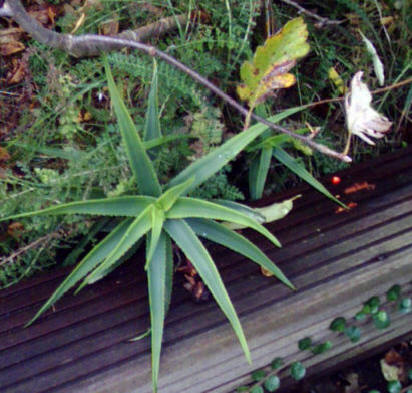
Aloe striatula in the garden of the hotel "Insulaner" in October 2005
Unfortunately, the large Agave americana var. marginata appeared to be dead although one leaf was still fresh and green. Agave americana can only be planted out here with a wind resistant rain protection and has to be kept completely dry during the winter. However, there are many other agave species which could be tested on Heligoland. For the example Agave montana, A. americana ssp. protoamericana (might be more hardy, and more reliable here than Agave americana) and further two promising species which might be able to cope with low temperatures and a higher humidity. Especially Agave montana originating from the mountain forests at high altitudes in Mexico is hardy to 5°F and might tolerates more humidity. The specimens we have however are still too small to be planted on Heligoland right now and have to reach the size of at least a few inches first.
I was very surprised to see the 'Carrizo Citrange' alive and with fresh new shoots. Mrs. Rickmers had cut off the damaged shoots like she did with Acacia dealbata. The Carizzo is probably the only citrus tree which survived on Heligoland. Poncirus trifoliata still was partly green but has not produced a new growth flush this year. So, Poncirus trifoliata or Poncirus hybrids can only thrive here on Heligoland in very sheltered spots in Down Town Heligoland City under the same conditions like oleander.
Hibanobambusa tranquillans 'Shiroshima' at the blue wall of the hotel also like fine and the olive tree from Joerg Witticke has grown new shoots from the trunk.
Unfortunately, Phyllostachys iridescens was gone. It probably was too dry here for this species but Phyllostachys aurea at the wood pavillon at the stairs has survived and seems to be well established there.
The Phoenix canariensis standing in a pot in the garden of the hotel "Insulaner" has not fully recovered and has suffered from the salty wind in winter and in addition to that it was also kept to dry. However, we believe it could grow well in sheltered places similar to that at the power station and that the two Phoenix canariensis planted in the atria of James Kruess School would have a much better chance to establish.
Then we examined a trachycarpus which was approx. 7 feet tall but the largest windmill palm grows in the Upper Town. This palm even flowered but the spadices were blown away during a heavy storm. We traced another but smaller trachy next to a Fatsia japonica downtown and this one came through the last winter without any foliage damage.
Finally we went to the ferry house "Marina" were I took a close look at the Chamaerops humilis and Furcraea longaeva 'Variegata' standing there in pots and found them in good condition.
Having examined all exotic plants on Heligoland we went back to Hamburg by the Halunder Jet. We have found out some interesting facts and have proved that some things are possible on Heligoland which were formerly regarded as impossible.
We would like to thank all the donators of plants, the sponsors and especially Ulf Martens who unrestlessly supports our project.
We are of course always open for any suggestions and Ulf and many Heligolandians will appreaciate and be grateful for every single donated plant used in our cultivation suitablity tests!
Photo Gallery About The Inspection Round October 2005 (unfortunately only in German, please click the link on!)
Author: Joachim Jaeck
Translated November, 18th, 2005